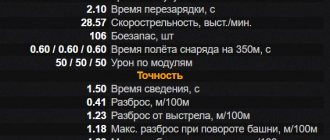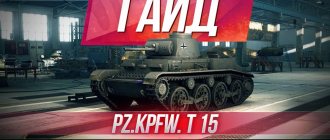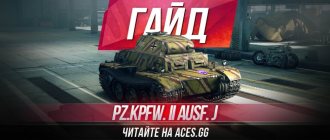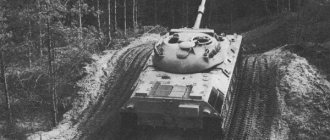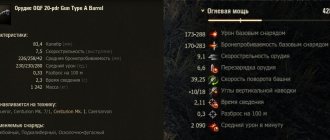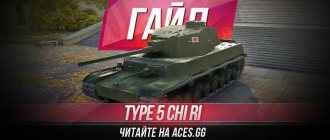Hello to all speed lovers, aces.gg is here! We will now talk about a new, very interesting and strong vehicle, which appeared on the main servers of World of Tanks with the release of update 0.9.18. We are talking about an American light tank of the tenth level - this is the XM551 Sheridan guide
.
Looking ahead a little, I would like to say that this device has the largest dimensions among all the new top-end fireflies, which does not have the best effect on the gameplay of the XM551 Sheridan WoT
. However, the American has a number of significant advantages that make him a very difficult opponent.
TTX XM551 Sheridan
First of all, every owner of this unit should know that it has a significant margin of safety, but it is still lower when compared with the amount of HP of other top-end vehicles (TT, ST, tank destroyers). But it is much more important to understand that the XM551 Sheridan has a review
simply amazing, initially this figure is as much as 420 meters.
Unfortunately, in terms of security, our American is very weak, however, like most light tanks in our favorite game. has characteristics
reservations are very scarce, you can see this by looking at the numbers in the performance characteristics and the vehicle model, that is, they will be able to get through us equally easily both sideways and head-on. By the way, you should also know that we have an ammunition rack on the sides and it is often criticized.
the American light tank XM551 Sheridan can hope for is
- a tower that, due to its streamlined shape, will sometimes ricochet, but this will only happen on major holidays. By the way, the grille that is installed in our forehead is not displayed on the vehicle model, which means it is too early to talk about whether it will be an anti-cumulative screen.
As mentioned at the beginning, XM551 Sheridan World of Tanks
It has large dimensions and a high silhouette, which means that it is not so easy to hit us even while moving, it is not possible to hide behind every obstacle, but more importantly, this nuance does not have the best effect on camouflage.
However, due to the weak armor and barn-like dimensions, one should not despair too much, since the real strength of the American is mobility. XM551 Sheridan tank
now it has become the owner of a very high maximum speed, excellent dynamics and remarkable maneuverability, which makes it very mobile and dynamic.
Selecting equipment and crew perks for the XM551 Sheridan
Additional equipment for the vehicle is selected taking into account existing shortcomings in order to increase the effectiveness of the tank in battles. However, in the case of the XM551-Sheridan, you need to try to maximize the positive characteristics, because it is impossible to compensate for the lack of armor and high silhouette with additional equipment. So, the slots can be filled with the following modules:
- Rammer.
- Stabilization of the gun.
- Ventilation.
It is possible to install coated optics on the XM551-Sheridan, but the vehicle already has one of the best visibility indicators in the game, but improving all the indicators of the XM551-Sheridan with the help of improved ventilation will be necessary in battle.
The crew of the vehicle consists of four tankers. Considering that the commander has to replace the absent radio operator, the perks are studied in the following sequence: The combat consumables slots are filled as standard, however, the fire extinguisher can be replaced with a box of cola.
gun
This unit owes its uniqueness, which was mentioned at the very beginning, to the weapons, because we are given two guns to choose from, each of which has its own pros and cons, but both of them deserve attention.
the XM551 Sheridan has
with a caliber of 152 millimeters - that is, a high explosive. Its advantage lies in the huge one-time damage, which, if fully penetrated, brings a lot of positive emotions.
But the problem lies precisely in this very penetration, because it is in the case of the XM551 Sheridan World of Tanks
really low. For this reason, this barrel can be perceived more as a “fun” barrel, but it cannot be called reliable, because when shooting at armored vehicles, you can often see a figure of 300 or even 200 damage.
In addition, in this configuration the American light tank XM551 Sheridan
has very poor accuracy, which is expressed in huge dispersion, poor stabilization and long convergence. That is, to carry out an aimed shot, in most cases you need to either drive up close to the enemy, or move for a long time without moving.
The second weapon option is much more reliable, we are talking about a gun with a caliber of 105 millimeters, which still has impressive one-time damage and a good rate of fire, due to which the XM551 Sheridan WoT
can deal about 2540 damage per minute without taking into account equipment and perks.
The penetration rates of this weapon are significantly higher. Of course, this does not give you the opportunity to penetrate most top tanks head-on, but targeting vulnerable spots or driving into the enemy’s sides is a real pleasure in dealing damage.
Despite the fact that the spread with this XM551 Sheridan tank
It is still quite large, the aiming speed is very high, and its excellent stabilization makes it possible to very confidently hit the target at maximum speed even at medium distances.
By the way, with both XM551 Sheridan USA
is the owner of comfortable vertical aiming angles, the barrels bend down by 10 and rise by 20 degrees, which allows you to confidently play with the terrain.
Advantages and disadvantages
You all understand perfectly well that for an effective and confident game it is very important to clearly understand the main strengths and weaknesses of your tank. But please take into account what's next XM551 Sheridan guide
will continue precisely from the position that a 105-mm gun is installed on board. You are free to choose the weapon yourself, both options are good in their own way, but this barrel is reliable and this is its advantage. Pros: • Excellent viewing range; • Very good mobility; • Decent one-time damage and DPM; • Excellent stabilization and convergence speed; • Comfortable vertical aiming angles. Cons: • Small margin of safety; • Very weak armor; • Barn dimensions affecting camouflage; • Large scatter; • Frequent ammo crits.
Equipment for XM551 Sheridan
You can and should select additional modules based on the list of advantages and disadvantages of the machine. In our case, there are no weaknesses that could be leveled in this aspect, which means we can fully concentrate on the advantages, therefore, equipment for the XM551 Sheridan tank
It’s better to put this: 1. – will give you the opportunity to shoot more often, which has a positive effect on damage per minute, which is already very good. 2. is an excellent choice, thanks to which you will not only be able to shoot even more confidently while moving, but will also be less likely to crumple after stopping. 3. – with such a high basic visibility, you can even bring it to top values with this module, while receiving a bonus to firepower and shooting comfort.
Light tank M551 Sheridan (USA)
For more than thirty years, the US Army was armed with the M551 Sheridan light tank, created as an armored reconnaissance vehicle and a means of fire support for the landing force. The Sheridans had to fight and demonstrate all their best and worst qualities. The results of operating the M551 turned out to be mixed, and became one of the reasons for the Pentagon’s abandonment of light tanks as a class.
Experimental tank XM551 No. 6 from the second series in the museum
AR/AAV program
In 1959, the Army launched a new program to develop the Armored Reconnaissance/Airborne Assault Vehicle (AR/AAV).
The new model was supposed to go to armored cavalry and airborne units, where it was to replace the M41 Walker Bulldog light tanks and the M56 Scorpion self-propelled guns, respectively. At the customer's request, the AR/AAV vehicle had to weigh no more than 10 tons and have small dimensions, which was necessary for air transportation and landing. The armament was supposed to ensure combat against existing medium tanks of a potential enemy at any time of the day. In essence, we were talking about a light amphibious tank with bulletproof armor and powerful weapons. Subsequently, the requirements for the project changed. In particular, to achieve the required combat qualities, it was necessary to increase the permissible combat weight by one and a half times.
According to initial plans, the AR/AAV program should have spent $1.05 billion and built more than 2,400 tanks. However, later plans changed - the cost of the program increased, and the amount of equipment decreased.
The 12th experimental Sheridan is the standard for the series
In the fall of 1959, 12 companies with multiple projects joined the AR/AAV program. In December, the Pentagon selected two of the most successful proposals, one of which came from Cadillac Gage (a division of General Motors). A few months later, the competing companies presented preliminary designs. In June 1960, the winner of the AR/AAV program was recognized. Her project, accepted for further development, received the working index XM551. The tank was later named in honor of General Philip Sheridan.
The following months were spent on design development, construction and testing of individual components. Also, engineers and military personnel had to waste time arguing. According to the project, the XM551 was supposed to carry a CVWS (Combat Vehicle Weapon System) weapon system with a large-caliber gun-launcher. This feature of the tank became a reason for criticism, and its supporters had to defend their point of view until 1962.
In the summer of 1962, the first prototype was built. The standard Sheridan fighting compartment was installed on the chassis of the M41 tank. The development of new missile and gun weapons took several years, which threatened the overall progress of the project. Nevertheless, work continued.
Experienced Sheridan No. 12 on the water. Removable screen visible
In the summer of the same year, the first series of three experimental XM551 tanks entered testing. In 1963-64. Two more series of prototypes appeared. As testing progressed, various changes were made to the project, affecting certain elements of the tank. However, the general provisions of the project did not change. At the beginning of 1965, the 12th experimental XM551 was built, which became the standard for the subsequent series.
In the spring of 1965, a contract appeared for the mass production of M551 tanks; The main contractor was Cadillac Gage. Several other organizations were also involved in the release. In May 1966, an order was issued to put the light tank into service. At the same time, the industry received instructions to improve the tank, which should have been carried out during production.
Design Features
The M551 Sheridan light tank was built according to a classic layout using proven solutions.
At the same time, a lot of new ideas, components and technologies were used. In this respect, the Sheridan was noticeably different from other armored vehicles of its time. After all the changes during development, an armored body was created from aluminum alloy “7039”. The welded tower received homogeneous steel armor. The frontal projection of such a tank could withstand 20 mm shells; other elements protected against 14.5 mm bullets. A collective anti-nuclear protection system and fire extinguishing equipment were provided.
Tanker with MGM-51 Shillelagh missile
A Detroit Diesel 6V53T diesel engine with a power of 300 hp was placed in the rear of the tank. with TG-250 transmission based on a hydrodynamic gearbox. Five large-diameter road wheels with tires were installed on board. Suspension – torsion bar. The front and rear pairs of rollers received hydraulic shock absorbers. During development, the tank lost its stern propellers; it was proposed to float by rewinding the tracks. The increase in combat weight led to the need to provide buoyancy through a removable annular screen.
As part of the CVWS program, a weapon system was created based on the M81E1 gun-launcher with a caliber of 152 mm. The gun had a piston bolt and a 17.5-caliber barrel. The gun was mounted on recoil devices with a hydraulic brake and a spring knurl. The gun mount provided vertical guidance within the range from -8° to +19.5°.
The ammunition included unitary shots with several types of burning cartridges. The high-explosive fragmentation M657, grapeshot M625A1, cumulative M409 and incendiary M410 were created. The main anti-tank weapon of the tank was the MGM-51 Shillelagh guided missile. The ammunition carried included 20 shells of all types and 9 missiles in different configurations.
Rocket shooting
The M551 had sighting devices for all weapons. The gunner had an M119 day sight and an M44 night sight, as well as an M31 product for indirect shooting. The gunner also worked with the control devices of the Shilleila complex. The missile was controlled in a semi-automatic mode: the gunner had to keep the target in sight, and the instruments generated commands for the missile. MGM-51 missiles made it possible to increase the probability of hitting targets at distances of 2-3 km.
Secondary weapons included a normal-caliber M73 coaxial machine gun and an M2 heavy-caliber anti-aircraft machine gun mounted on the commander's cupola. On the cheekbones of the turret there were two four-barrel smoke grenade launchers.
Other weapon options were also being explored. In 1967, two prototypes with alternative weapons were built. One carried a 76 mm tank gun, the other a 105 mm howitzer. However, production M551s received only the CVWS complex with the M81 gun.
The tank's crew included four people with traditional accommodation. All workplaces were equipped with the necessary hatches and inspection devices. There was an intercom with an external telephone.
M551 (probably Two Box version) in Vietnam
The M551 Sheridan had a length of 6.3 m, a width of 2.8 m and a height of 2.95 m. The combat weight of production vehicles was approx. 15.2 tons. The tank could accelerate on the highway to 70 km/h or up to 5 km/h on the water. Cruising range on the highway is 565 km. It could be transported by military transport aircraft and helicopters, as well as dropped in various ways.
From the late seventies to the early nineties, several technology upgrades were carried out. As a result, the M73 machine guns were replaced with newer M240s, AN/VSG-2 thermal imaging sights and new night devices for the driver appeared. Improved vehicles received the designations M551A1 and M551A2.
Tanks in service
Assembly of the first production Sheridans began in 1966, and a year later they entered combat units. Production continued until 1970, and during this time 1,662 light tanks were built. The total cost of the AR/AAV program, taking into account development and series, reached $1.3 billion - the result was noticeably different from plans.
Transporting Sheridan by air using a CH-54 helicopter
Production M551s were supplied only to the US Army, but foreign orders could appear. An export version of the tank, devoid of guided missiles, was proposed for foreign armies. Great Britain and Australia became interested in the technology and tested it at their test sites, but were dissatisfied. The United States remained the sole operator of the Sheridan.
Armored cavalry units were the first to receive new equipment. The cavalry squadron from the ground division was entitled to 27 tanks - 9 for each of the 3 companies. Separate armored cavalry regiments included three such squadrons with 27 tanks each and 3 vehicles for headquarters. Airborne units rearmed in a similar way. At the same time, it was the infantry and tank divisions that received most of the light tanks.
New equipment was distributed between units both in the United States and at foreign bases. Quite quickly, tanks appeared in all strategic directions. Since 1966, consideration has been given to sending units with the M551 to Vietnam to participate in combat operations.
"Sheridans" in battle
Until mid-1968, sending light tanks to war was a matter of controversy. Production vehicles did not yet fully meet the requirements due to problems with optical instruments, lack of grapeshot projectile, etc. In addition, the armor of the tanks raised questions: commanders doubted that such protection would ensure the survival of the equipment in the typical conditions of the Vietnam War.
Landing of tanks during an exercise, 1984
By mid-1968, all these shortcomings had not yet been corrected, but the command decided to send the equipment to Vietnam. The first batch of tanks lost their guided weapons, instead of which they placed additional stowage for machine gun cartridges. Due to the characteristic features of the redesigned interior, such M551 received the nickname Two Box - “Two Boxes”. Subsequently, new tanks underwent such modifications. A total of 226 cars were rebuilt.
The first M551s arrived in Vietnam at the very beginning of 1969. 64 vehicles were distributed among several units for different purposes, which made it possible to test the equipment in all major roles. At the end of January, the first battle with the participation of the Sheridans took place. While on night duty at a fortified position, the crews of two tanks discovered enemy movement and fired several shots, disrupting the attack.
Based on the results of the first months of operation, a decision was made to increase the number of M551s in Vietnam. By the beginning of 1970, units simultaneously had about 200 such tanks. In 1971, they began to be gradually withdrawn, and the number of “active” equipment was constantly decreasing. In total, several hundred M551 tanks took part in the war. About 90 vehicles were destroyed by the enemy. Over 200 were repaired after damage and returned to service.
M551A1 light tank and its ammunition during Operation Desert Storm, 1991.
The next time Sheridan saw action was during the invasion of Panama in 1989. Four of these tanks were delivered to the battle site in advance, and eight others were parachuted. One was damaged due to a parachute system failure, but the others helped the soldiers of the 82nd Airborne Division solve their combat mission.
In August 1990, the 82nd Division and its armored vehicles traveled to Saudi Arabia. During Desert Storm, M551 tanks took part in battles and used all available weapons. It is known about the successful use of the MGM-51 missile, which destroyed the Iraqi T-55 tank.
Leaving service
The fighting in the Middle East was the last serious episode in the biography of the M551 Sheridan tank. By this time, numerous shortcomings of the machine became obvious, which interfered with its effective operation. A new similar replacement model was expected to appear in the near future.
Tank "Sheridan" of the 60th motorized rifle regiment. Due to the body kit, the Soviet T-80 MBT is imitated
Operational problems began back in the sixties, and since then the situation has not changed dramatically. Already in the seventies, some units were transferred from the imperfect M551 to other equipment. Subsequently, similar processes continued, and by the mid-nineties, the Sheridans remained only with the 82nd Airborne Division. In 1996, its battalion, armed with the M551, was disbanded.
Until 2004, M551A2 tanks continued to serve in the 60th Motorized Rifle Regiment at the training center at Fort Irwin. These vehicles were imitators of foreign armored vehicles and were used in exercises.
During their service, the M551 Sheridan light airborne tanks showed mixed results. They had high firepower and could hit various targets; the low mass simplified the transfer and increased mobility on the battlefield. At the same time, the armor only protected against small-caliber artillery, but not against more powerful shells or mines. In addition, various problems with instrumentation constantly appeared, incl. with weapons controls.
By the mid-nineties, the M551 Sheridan was hopelessly outdated in all respects, which led to the decommissioning of the last vehicles from the line parts. It was expected that a new light tank would soon appear to replace the retired vehicles, but this did not happen. Thus, the M551 still retains its status as the last light tank of the US Army.
Crew training
Regarding prioritization when leveling up skills for the crew, which in our case consists of four people, it is worth sticking to the already outlined plan. This means that we again give preference to shooting comfort, firepower and visibility, but here we should also include survivability, that is, perks for the XM551 Sheridan
learn according to this principle: • Commander (radio operator) – , , , . • Gunner – , , , . • Driver mechanic - , , , . • Charger – , , , .
Tactics for playing the XM551 Sheridan
The gameplay on this device is very dynamic and requires maximum concentration from the player, the ability to make decisions quickly and correctly, as well as act carefully, but at the same time boldly, because otherwise the potential of the XM551 Sheridan WoT
it will be hard.
Regarding exactly how you need to act, first of all you will have to illuminate enemy positions. It is possible to shine passively on this American, but it is dangerous due to the fact that the XM551 Sheridan tank
has large dimensions. However, a proactive style of providing your team with intelligence is exactly what you need.
I use excellent mobility, even taking into account the large dimensions, it will not be easy for the enemy to hit you. However, driving around in an open field is also not the best option, for the XM551 Sheridan tactics
a more secretive one is suitable for illumination. This means that you must take advantage of the folds of the terrain, “diving” into them, or make dashes between houses and other shelters, then appearing and then disappearing from the enemy’s visibility.
At the same time, do not miss the opportunity to implement your DPM, because the XM551 Sheridan World of Tanks
really good. You can hit the target without slowing down, carousel the enemy, shooting him into vulnerable areas, or fire from the second line, remaining in cover.
In other words, the American XM551 Sheridan light tank
- This is a flexible machine that can be used in many ways, but do not forget about the cardboard armor, which absorbs land mines with full damage, that is, try to play moderately carefully.
Historical facts of XM551 Sheridan
XM551 is a pre-production prototype of the American light airborne tank M551 Sheridan. A limited number of prototypes were produced in 1965, with mass production of the base model beginning in 1967. The main armament was an innovative 152-mm M81 cannon of reduced length, capable of firing both shells and guided anti-tank missiles (ammunition: 20 high-explosive shells and 10 ATGMs). Additional weapons are two machine guns: 7.62 mm coaxial with a cannon, and 12.7 mm anti-aircraft. The armor is light, made from sheets of aluminum-magnesium-zinc alloy. The frontal armor of the tank protects against fire from large-caliber machine guns and 20-25 mm automatic cannons, while the side and rear armor protects against small arms fire and shrapnel. The tank could float and had the ability to airdrop using parachute systems. The Sheridan tank saw combat use in three conflicts: the Vietnam War, the US invasion of Panama in 1989, and Operation Desert Storm in 1991.
